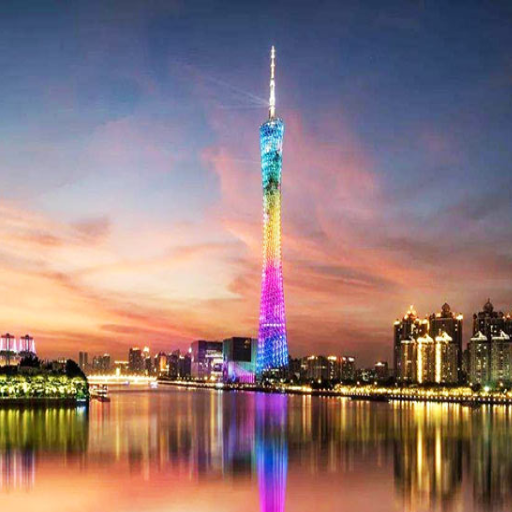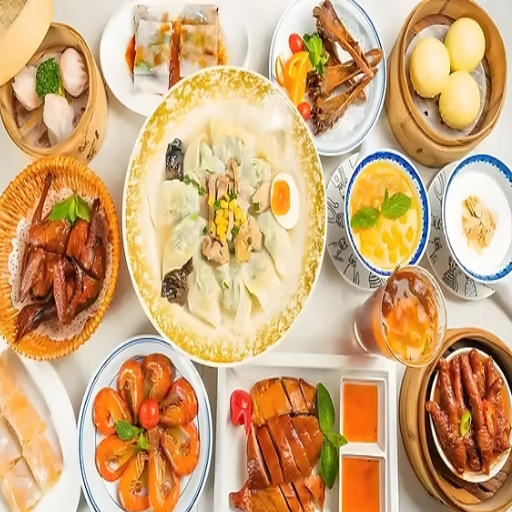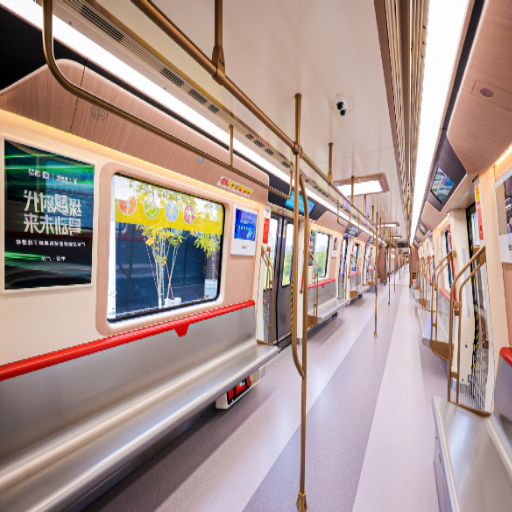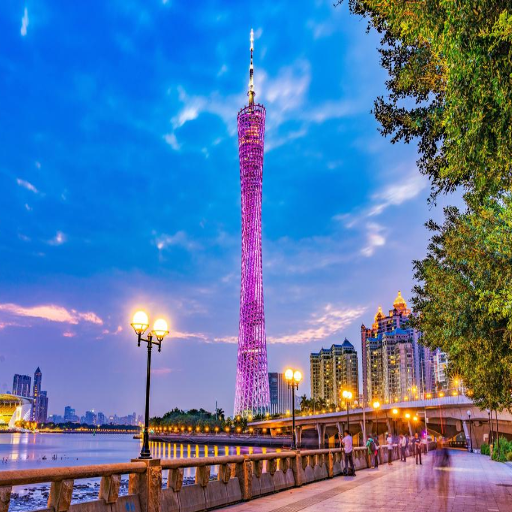Let me tell you about Guangzhou, a beautiful city in Southern China popular for its ancient monuments, soaring towers, and amazing Cantonese dishes. It can be a lot to take in at once, which is why, in the following paragraphs, I plan to make the appearance of this city more comprehensible for visitors. Trying to balance ancient Chinese temples, modern skyscrapers, and decadent cuisine can be challenging, so my guide is here to make the planning a little easier. For first-time and seasoned travelers, there is something all can enjoy regarding the bustling city of Guangzhou.
What are the top things to do in Guangzhou?

Must-visit attractions in Guangzhou’s Yuexiu Park
Yuexiu Park is famous for being the largest urban park in Guangzhou, combining natural scenery with cultural sites. The park has several attractions, some of which include:
Five Rams Statue—This stunning sculpture illustrates the definition of passionate art and Guangzhou’s nickname, “City of the Rams.” It also serves as a perfect photo opportunity.
Zhenhai Tower (Five-Story Pagoda) – A historic tower that ] is now the Guangzhou Museum where you can enjoy numerous art objects and admire the city’s beautiful views.
Sun Yat-sen Monument—One of the monuments built in Zhu Jiang Park, this monument commemorates the revolutionary leader of China and is surrounded by soothing gardens.
Ancient city wall—A portion of Guangzhou’s walls from the Ming dynasty gives insight into the city’s defenses’ history.
Yuexiu Hill and Scenic Lakes—The hill and the scenic lakes are incredibly beautiful, perfect for casual strolls, and offer a tranquil escape from the busy city life.
With its wide array of stunning views and cultural emblazonment, Yuexiu Park will leave any traveler speechless with its extravagant history and striking existence in Guangzhou. So plan your comfy travel shoes, as the park covers approximately 860,000 meters and is filled with wonders!
Exploring Canton Tower and Pearl River cruise experiences
Canton Tower is one of the most distinguishable sights in Guangzhou, with a height of 600 meters. It contains several entertainment options, like the observation decks, the 4D cinema, and the Gravity-Defying Bubble Tram, all of which provide breathtaking city views. The primary observation deck, at 449 meters, is where visitors capture the real beauty of Guangzhou. To top it off, the tower’s spectacular night view is enhanced by the city’s LED lights and colors.
The Pearl River cruise avails an exceptional alternative for tourists to enjoy style attractions along the riverside. The Cruises are 1 to 2 hours long and include famous spots like Shamian Island, the Guangzhou Opera House, and The Canton Tower. The ships are designed for luxury and comfort, with reliable air conditioning and pleasant seats, making the cruise more enjoyable than the evening cruise around sunset. The best plan is to combine the tower from a distance and the Pearl River cruise, which exhibits the city’s grandeur and nature.
Historical sites at Shamian Island and Six Banyan Trees
Shamian Island is an ancient region of Guangzhou that encapsulates foreign-influenced architecture. The island features Western-style buildings, restored structures, gardens, and cobblestone streets, which showcase how China interacted with Western countries during the late 1800s and early 1900s. Important tourist attractions such as Lourdes Chapel and other consulates are well-kept and showcase European architecture.
The Buddhist historical site, Liurong Temple, boasts a rich history extending beyond 1,400 years and is rumored to have been constructed around the Song dynasty. The iconic Flower Pagoda, standing tall at 57 meters, is the most astonishing part of the temple with its unique octagon shape, making it even more fascinating. The temple hosts astounding relics with intricate carvings and peaceful courtyards, making it a place for cultural appreciation and meditation. All parts of the structure were carefully designed and built using modern archeological methods and traditional techniques for historical accuracy.
When is the best time to visit Guangzhou?

Seasonal weather patterns in Guangdong Province
Guangzhou and its areas in the Guangdong Province have a humid subtropical climate, classified into four seasons. If you plan to travel to this region, you may want to do so in the ideal weather. During spring, which stretches from March to May, temperatures fluctuate between 15-25 degrees Celsius, accompanied by blooming flowers and small rain showers. While spring is very pleasing, it is also the most humid season, with up to 80% humidity levels, which is very uncomfortable for most people.
During the summer months of June to September, temperatures ranging from 24 to 35 degrees Celsius will also come with heavy rain. There is an eye-of-the-storm feeling due to the high humidity, lush greenery, and warm temperatures. Along with the high temperatures and moisture comes the chance of typhoons bringing in pouring rain and storms. If you travel here during this time, come prepared with light clothing and breathable rain gear.
The autumn months, witnessing the shift of October to November, are regarded as the most beautiful time to visit Guangzhou. Fresh, less humid skies are accompanied by soft rains. Temperatures range from 18 to 28 degrees Celsius, allowing you to truly experience the beauty of Guangzhou.
Because of the warmer weather, sightseeing and outdoor activities are very enjoyable during this time. Winters are always from December to February and are the most mild, with temperatures hovering between 50°F and 64°F (10 to 18 degrees Celsius). For southern China, this would be considered cold; however, compared to the northern regions, it’s thriving. This is perfect if you are trying to escape the summer heat and humidity.
Planning around the Canton Fair dates
The Canton Fair is one of the largest trade fairs in the world and occurs twice a year. It’s mid-April to early May for spring and mid-October to early November for autumn. If you plan to visit Guangzhou, be wary of the incredible number of tourists who will affect the prices of hotels. Quadruple your anticipated budget to stay in a moderately priced hotel during this peak season.
The Canton Fair is divided into three phases to facilitate easier control of these large crowds. Each phase is tailored for different industries and products:
Phase 1: Electronics, Lighting, Machinery, Tools and Hardware.
Phase 2: Consumer merchandise, Gifts, and Home decorations.
Phase 3: Healthcare products, Office supplies, Footwear, Textiles, and Garments.
This phase is the most straightforward. Each phase is dedicated to five days and separated by a few days in between. Make sure to memorize these timelines, as each phase has a corresponding specific event. Proper time management is paramount at these events—the more focused your plans, the deeper the benefits for your business and overall experience.
Optimal months for experiencing Guangzhou’s attractions
The best times to visit Guangzhou, famous for its culture and breathtaking city views, are from October to December and March to April. The city’s temperature averages 15 to 25 degrees Celsius and has low humidity. Such warm weather makes it easier to enjoy outdoor physical activities, including hiking and sightseeing. Baiyun Mountain, the Pearl River, and Shamian Island are hot spots that can be explored more during favorable weather.
Guangzhou benefits from the region’s brisk autumn air and pleasant weather from October to December. This period overlaps with the Canton Fair, an international trade exhibition attracting worldwide tourists. Cultural and business activities, such as visiting historical places, are popular during this time. Moreover, this time of the year is splendid for food lovers since Cantonese cuisine is even better during autumn.
From March to April, the charming city of Guangzhou experiences beautiful greenery and blossoming flowers, enhancing the city’s parks like Yuexiu Park and the South China Botanical Garden. The town gets a little rainfall during spring, but it is not too drastic to hinder venturing outside since the city has numerous sheltered walkways and ample public transport options. Those who are planning a trip to Guangzhou would have a much easier time if they check out the weather forecasts and pack some light rain clothing.
What can you eat in Guangzhou to enjoy authentic Cantonese cuisine?

Essential dim sum experiences in China’s food capital
Guangzhou boasts pride in its Cantonese cuisine, especially the dim sum. No trip to this part of the world is complete without tasting its world-famous dim sum. In literal translation, dim sum means ‘touch the heart.’ It encompasses many small, delicious dishes usually served with tea. Some delectable items that make the did sum experience complete are har gow, which are shrimp dumplings having a see-through skin filled with shrimp, and siu mai, which is a laced topping of shrimp and pork accompanied with roe put forth in the shape of a dumpling. Another lovely treat is char siu bao, sweet barbeque pork buns known for their fluffy, light, and sweet taste.
To enjoy authentic dim sum, visit unique tea houses or well-known dim sum restaurants such as Tao Tao Ju or renowned restaurants like Guangzhou Restaurant. These long-established restaurants have a history of crafting these delicacies. Precise cooking methods include steaming the meal in bamboo baskets or deep-frying it. Each form gives a crispy outer layer while the inner delicacy is tender. Dim sum can be paired with jasmine or puer tea to enhance its taste for a complete cleansing effect in between bites.
Traditional Cantonese dishes you must try
Char Siu (Barbecued Pork): With sweet and savory flavors that mingle together in perfect cohesion, char siu is a spectacular dish made from thick pieces of pork marinated in honey, soy sauce, hoisin sauce, and Chinese five-spice powder. After marinating, the pork is oven-roasted to caramelize it, making it tender and flavorful.
Har Gow: The dumplings look deceptively simple, consisting of a thin wrapper filled with shrimp seasoned to perfection, but their step at the base requires incredible skill. A precise ratio of wheat starch to water makes the dough’s chewy nature perfectly balanced.
Roast Goose: Perhaps the single most important dish in Cantonese cuisine, roast goose stands out because of its unique soft meat, crunchy outer skin, and sweet marinating flavor. Soy sauce, five spices, garlic, sugar, and soy sauce provide the signature flavor, which is then sealed in through open-fire roasting in specialized ovens.
Clay Pot Rice: Searing hot clay pots gives this dish a unique visual flair that instantly grabs one’s attention. The fragrant rice served is topped with chicken, dried Chinese sausage, mushrooms, or a generous helping of both. This dish is unique because the crispy bottom layer of rice perfectly blends with the tender topping.
These four examples accurately pinpoint what distinguishes traditional Cantonese cooking: a rich blend of flavors, hearty portions, and a solid set of cooking skills.
Best restaurants and food streets in Guangzhou
Guangzhou is famous as the heart of food in China due to its food streets and wide selection of places to dine in. Here are some of the best places to try out throngs of foods offered in the city:
Taotaoju Restaurant: For Guangzhou cuisine lovers, Taotaoju is a place in Guangzhou that has been serving authentic Cantonese dim sum and mouth-watering traditional dishes since 1880 and continues to do so even today. While Taotaoju is famous for its shrimp dumplings and barbecued pork buns, it describes the culinary heritage of Guangdong.
Guangzhou Restaurant: Guangzhou Restaurant boasts a long-standing reputation for its roasted goose and braised abalone, a trademarked dish that accurately describes China’s refined Cantonese cuisine. Their serving of exquisite ingredients and their preparation qualitatively is one of the best you could find.
Beijing Road Food Street: Roasted chestnuts, stinky tofu, and rice noodle rolls are popular local dishes. Due to the wide variety of stalls available, people love this place and consider it a hub for street food. The energetic atmosphere, along with delicious and diverse street food, accurately represents Guangzhou culture.
Shangxiajiu Pedestrian Street: This food street uniquely represents the modern and older Guangzhai, which is sure to be loved by anyone who admires beautiful architecture. Among the food served, you can find wonton noodles, double-skin milk pudding, and the ever-tasty crispy egg tarts, which help you experience true Cantonese snacks.
Haizhu Square Night Market: This is a great place to get food after dusk. The vendors serve grilled seafood, handmade desserts, and spicy skewers. You must visit this place to enjoy the city’s nightlife and food culture fully.
These places are well known because of their diversity and authentic nature, making them unique. Anyone who wants to explore the rich flavors of Guangzhou should visit this place. If eating on the side of the street or in a fine restaurant is your style, this place will cater to your needs.
How do you get around Guangzhou efficiently?

Navigating from Guangzhou Baiyun International Airport
A well-planned city of Guangzhou transportation system can be utilized to get from Guangzhou Baiyun International Airport to any destination. The metro system is one of the easiest and most convenient modes of transport, particularly Line 3, which connects the airport to the downtown area. It also reduces expenses and possible traffic jams, saving you time. To use the metro, buses, and some taxis, purchase a Yang Cheng Tong card beforehand, as it is rechargeable.
At the airport, taxi services are also available; however, you should expect the prices to change as a function of traffic and the journey’s length. To minimize such problems, it’s usually best to board the taxis through the designated taxi ranks after ensuring they are equipped with a working meter. If you want more comfort or carry a lot of heavy luggage, ride-hailing services or airport shuttles would be ideal. Making plans is highly recommended, as Guangzhou has a heavy traffic issue throughout.
Using Guangzhou’s metro and public transportation system
I think the most effective way of traveling within Guangzhou is by using the metro system. It is quick, dependable, and covers nearly all significant landmarks like tourist centers and business hubs. I would suggest getting a Yang Cheng Tong card because it provides added benefits by working on the metro, buses, and even some taxi services. With the Yang Cheng Tong card, my primary suggestion is to avoid the peak hours of the metro during the forex hours of 7-9 and 5-7, as it can get quite congested.
If your concern lies in the technical details, the metro runs from approximately 6 a.m. until midnight, with peak times ranging between 2 and 5 minutes and off-peak hours being 6 to 10 minutes. The charging basis is distance, starting at 200m for ease of journey and then increasing with distance. It is advisable to check the map and have your ticket ready since the layout of the stations, especially in important hubs, can be very large.
Day trips to Shenzhen and Dongguan from Guangzhou
Traveling to Shenzhen and Dongguan for a day trip from Guangzhou is the most efficient way to get there by train. Travel times using a high-speed train are roughly 30-40 minutes to Dongguan and around 1 hour to Shenzhen. Trains operate multiple times a day and can be booked online or manually. Prices for second-class seats typically start at 40-50 RMB, depending on the city one wishes to travel to.
Driving is also an option, as both cities are connected to Guangzhou by highways. However, traffic during peak hours can heavily affect the time it takes to get to either town from Guangzhou. While driving does allow freedom, it is expensive due to the toll fees put into play. Publically available buses are also available, but they attempt to travel on set schedules, which makes them unfit for day trips without a proper itinerary. This enables on-the-spot planning for trips to Shenzhen and Dongguan from Guangzhou.
What travel tips should first-time visitors know about Guangzhou?

Language essentials and communication in Guangzhou
Understanding the languages mentioned above can sometimes be helpful, but having a phrasebook or an app can make things easier. Cantonese is widely used in daily life, and it is a local dialect which means Mandarin or Putonghua is also spoken. English is rarely spoken in non-touristic areas, so knowing how to say simple things like greetings or asking for help could be helpful.
Basic smartphone applications like Google Maps would efficiently navigate these tourist locations. Most bigger establishments will provide signage in Mandarin and English but expect to see only Mandarin in local, smaller places like cafes or small shops. An internet-enabled Smartphone or Deepl/Google translate could work wonders in these situations.
Also, knowing universal communication norms can enhance your experience. It’s proper to refer to locals formally and refrain from overly informal speech. If you plan to take a taxi or use a rideshare, it is easier to show the driver your destination rather than tell them, primarily if it is written in Chinese characters. These details in preparation can allow you to enjoy Guangzhou more as you can move around the city effortlessly, regardless of the language barrier.
Cultural etiquette and customs in South China
While studying South China, I realized that following manners and customs increases the joy of the trip. For instance, speech etiquette demonstrates courtesy by using formal titles while strictly refraining from casual speech and emphasizing balance. This also conforms to the concern of facing embarrassment and the overall culture of respect. In terms of communication, having relevant information, such as the destination, written down in Chinese characters is crucial when using taxis or getting help locally.
In terms of offline resources, having a translation application with download options, such as Google Translate, is handy when dealing with smaller shops and markets that are unfamiliar with English. Trying to learn commonly used phrases in Mandarin may also help facilitate cultural engagement for foreigners. Hence, bringing along documents such as printed addresses or even simple aid translators can help ease language barriers for people visiting these regions of Guangzhou and its surroundings.
Frequently Asked Questions (FAQs)
Q: Where would be the best place for me to stay while I am in Guangzhou?
A: It will depend on what you plan to do while in Guangzhou and your budget. If you want luxury accommodation close to shopping malls and the Guangzhou Opera House, you will want to stay in the Tianhe district. This is a modern city center that is ideal for business travelers. For tourist attractions, the Pearl River, and mid-range hotels, you can head to the Haizhu district. The old city surrounding Beijing Road has historical sites that budget travelers love. Zhujiang New Town has Guangzhou’s tallest skyscrapers and expensive hotels, with serviced apartments available for those wanting to stay longer and experience a local setting.
Q: What are some places to visit in Guangzhou?
A: While in Guangzhou, check out some highlights, such as the Canton Tower, the Temple of the Six Banyan Trees, and the Chen Clan Ancestral Hall. The Guangzhou Museum contains the blueprint for the historical city, which is the capital city of Guangdong. The views from the cruises on the Pearl River are breathtaking, even more so after 8 p.m. when the skyline is illuminated with lights. The Five Ram Statue in Yuexiu Park is also stunning, representing the city’s heritage. For an active excursion, visit White Cloud Mountain, where nature offers a break alongside hiking paths and beautiful sequences of landscapes. Not to be missed are the Sacred Heart Cathedral and the Sun Yat-sen Memorial Hall, each with different features of art and culture of what is one of the most populated cities in China.
Q: Are Guangzhou Tours worth trying, and which tours do you recommend?
A: Yes. Guangzhou tours are beneficial for someone on their first trip. A guided day tour usually includes a hosted visit to the Temple of the Six Banyan Trees, Chen Clan Ancestral Hall, and the Five Ram Statue, centered around exquisite junior historical narration. For food tours, local guides give restaurant and market tours where Cantonese delicacies are served. They capture the skyline on specialized night Pearl River cruises for specialized photography tours. Guided walks around the old city and Beijing Road reveal a lot about the life of the people. Consider hiring private guides if you want an experience tailored to your tastes. Still, if you do not mind sharing the tour, you may opt for small group tours that typically provide transport between points of interest, which is always a plus in a city as big as this.
Q: What nightlife activities and options are available in Guangzhou?
A: One of the most outstanding features Guangzhou has to provide is its nightlife activities, varying from district to district. Zhujiang New Town has bars and clubs on the rooftops of new skyscrapers from which you can see the beautiful skyline at night. The Tianhe district is popular for its modern nightclubs, which expats and young professionals usually visit. The Haizhu area is much more local and more authentic. This is where local bars, which offer craft beers and rice wines, are located. Shops and street food on Shangxiajiu Pedestrian Street come to life at night. If you want a chill evening while seeing the city lights, Pearl River cruises are an option. Most places are open until two or three in the morning, while some Tianhe clubs stay open until sunrise. Don’t forget that the nightlife in these regions is not as sizzling as Shanghai and Beijing, but it certainly has a lot to offer.
Q: What are the essentials of a 3-day tour of Guangzhou?
A: When planning a 3-day trip to Guangzhou, it is essential to include historical locations, modern attractions, and tasty food. Day 1: Start your day at the Chen Clan Ancestral Hall, visit the Temple of the Six Banyan Trees, and spend the afternoon at the Guangzhou Museum. End the day with dinner in the old city. Day 2: Spend the morning at White Cloud Mountain, shopping at Beijing Road in the afternoon, and end the day with a cruise on Pearl River. Day 3: Enjoy the modern architecture of Zhujiang New Town, the famed Guangzhou Opera House, and Canton Tower, followed by a delicious Cantonese dinner. This schedule allows a traveler to enjoy both sides of the city, traditional and contemporary, during their visit.
Q: What is the easiest way to get around Guangzhou while I am there?
A: While staying in Guangzhou, using the metro system, which has 16 lines that cover major tourist attractions and shopping malls, is the most efficient way to navigate the city. I recommend purchasing a Yangchengtong card to access metros, buses, and ferries. Taxis are reasonably priced, but most drivers do not speak English, so make sure to have your destination written in Chinese characters. If you need to travel a short distance in the city center, Mobike and other bike-sharing services are a nice alternative. There are also river ferries that allow for travel along the Pearl River. Some areas, such as Beijing Road pedestrian street and parts of the old city, are pleasant to walk in. When traveling to Canton East Railway station or other transport hubs, add time to your commute during rush hours.
Q: Am I required to sign up for a newsletter before going on a trip to Guangzhou?
A: Signing up for a newsletter focused on Guangzhou or a travel-focused on China can be helpful. Tourist bureaus usually email seasonal updates regarding events, festivals, and special temporary exhibitions, which do not apply in guidebooks. Travel newsletters also inform relevant issues like the change of visa policy, which is vital for booking flights. Some specialized newsletters give tip-offs about restaurant openings, local happenings, and other undiscovered places. Most expatriate-focused websites have a newsletter of English resources about Guangzhou. In addition, registering for hotel newsletters might offer special deals. Simply choose one or two information-laden newsletters and be ready to limit overload, focusing on those about Guangzhou and Shenzhen or southern China instead of general China travel.